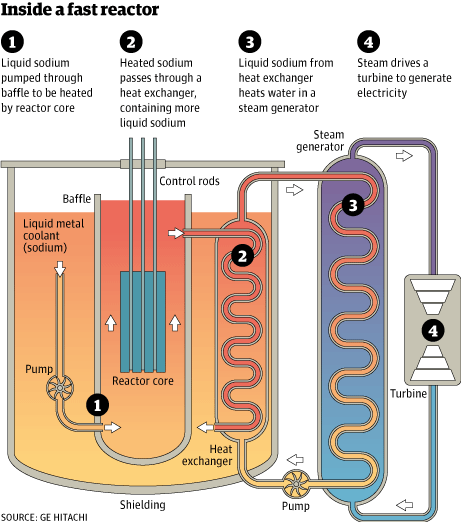Nuclear Power -> Nuclear Power Plant -> Types of Reactors -> Fast Neutron Reactor -> Breeder Reactor
Breeder Reactor

Source GE HITACHI
A breeder reactor is essentially a particular configuration of a fast reactor. Fast reactors generally have an excess of neutrons (due to low parasitic absorbtion), the neutrons given off by fission reactions can “breed” more fuel from otherwise non-fissionable isotopes or can be used for another purposes (e.g.,transmutation of spent nuclear fuel). The most common breeding reaction is an absorbtion reaction on uranium-238, where a plutonium-239 from non-fissionable uranium-238 is produced. A key parameter of breeder reactors is a breeding ratio, although this ratio describes also thermal reactors fuel cycle.
The term “breeder” refers to the types of configurations which can be the breeding ratio higher than 1. That means such reactors produce more fissionable fuel than they consume (i.e., more fissionable Pu-239 is produced from non-fissionable uranium-238, than consumed initial U-235+Pu-239 fuel).
Production of fissile material in a reactor occurs by neutron irradiation of fertile material, particularly uranium-238 and thorium-232. These materials are breeded, either in the fuel or in a breeder blanket surrounding the core.

Source:
Types of breeder reactors
- Fast breeder reactor (FBR). The superior neutron economy of a fast neutron reactor makes it possible to build a reactor that, after its initial fuel charge of plutonium, requires only natural (or even depleted) uranium feedstock as input to its fuel cycle. Russian BN-350 liquid-metal-cooled reactor was operated with a breeding ratio of over 1.2.
- Thermal breeder reactor. The excellent neutron capture characteristics of fissile uranium-233 make it possible to build a moderated reactor that, after its initial fuel charge of enriched uranium, plutonium or MOX, requires only thorium as input to its fuel cycle. Thorium-232 produces uranium-233 after neutron capture and beta decay.
Breeding vs. Burnup
All commercial light water reactors breed fuel, but they have low breeding ratios. In recent years, the commercial power industry has been emphasizing high-burnup fuels (up to 60 – 70 GWd/tU), which are typically enriched to higher percentages of U-235 (up to 5%). As burnup increases, a higher percentage of the total power produced in a reactor is due to the fuel bred inside the reactor.
At a burnup of 30 GWd/tU (gigawatt-days per metric ton of uranium), about 30% of the total energy released comes from bred plutonium. At 40 GWd/tU, that percentage increases to about forty percent. This corresponds to a breeding ratio for these reactors of about 0.4 to 0.5. That means, about half of the fissile fuel in these reactors is bred there. This effect extends the cycle length for such fuels to sometimes nearly twice what it would be otherwise. MOX fuel has a smaller breeding effect than U-235 fuel and is thus more challenging and slightly less economic to use due to a quicker drop off in reactivity through cycle life.